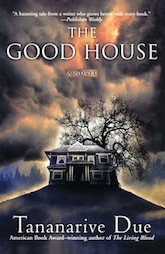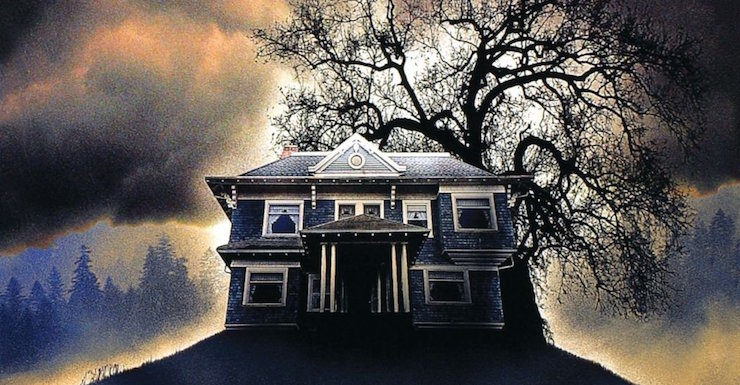In February of 2016, Fantastic Stories of the Imagination published an essay by me called “A Crash Course in the History of Black Science Fiction.” In the two years since, Tor.com has published my in-depth essays on fourteen of the 42 works mentioned. The original “Crash Course” listed those 42 titles in chronological order, but the essays skip around. In this fifteenth column I write about The Good House, a 2003 novel by the brilliant and brave award-winner Tananarive Due.
OUR LONG NIGHTMARE
 Daughter of civil rights activists, wife of another amazing African American author covered in my Crash Course (Steven Barnes), a formally trained and formerly practicing journalist, and holder of an endowed chair at Spelman College, Due has been around a few blocks a few times and seen a few issues in need of exploration. In The Good House she tackles the intersection—the collision, really—between violence and young black manhood. Starting out solidly in the point of view of Hollywood agent-to-the-emerging-stars Angela Toussaint, the novel recounts her son’s horrifying public suicide. Subsequent chapters deal with the spreading miasma of the rogue spirit that’s the root cause of Corey Toussaint’s death—a supernatural entity that’s as much to blame as the handgun the boy’s father, Angie’s ex, swore he’d disposed of. While explaining how an arrogant spell rendered the Toussaints vulnerable to this rogue spirit, the book also revisits the weeks preceding Corey’s self-inflicted headshot, helping readers understand his secrets and struggles, and finally revealing why he had to kill himself.
Daughter of civil rights activists, wife of another amazing African American author covered in my Crash Course (Steven Barnes), a formally trained and formerly practicing journalist, and holder of an endowed chair at Spelman College, Due has been around a few blocks a few times and seen a few issues in need of exploration. In The Good House she tackles the intersection—the collision, really—between violence and young black manhood. Starting out solidly in the point of view of Hollywood agent-to-the-emerging-stars Angela Toussaint, the novel recounts her son’s horrifying public suicide. Subsequent chapters deal with the spreading miasma of the rogue spirit that’s the root cause of Corey Toussaint’s death—a supernatural entity that’s as much to blame as the handgun the boy’s father, Angie’s ex, swore he’d disposed of. While explaining how an arrogant spell rendered the Toussaints vulnerable to this rogue spirit, the book also revisits the weeks preceding Corey’s self-inflicted headshot, helping readers understand his secrets and struggles, and finally revealing why he had to kill himself.
As I write this, just days after yet another school mass shooting, the violent murder of children is very much on my fellow USians’ minds. For African Americans and others in the diaspora, however, it’s a constant, the background of every moment of our waking lives. It’s why my youngest nephew wore a three-piece suit to class each day for months on end. It’s why Angie Toussaint insists on dragging her son out of the city, site of potential gang activity, to the sleepy little Pacific Northwest village where he nonetheless dies.
DEPENDING ON THE KINDNESS OF STRANGERS
Sacajawea, Angie’s fictional hometown, owes much to real life population-500-plus Cathlamet, Washington, where Due lived when she wrote The Good House. It’s not the ghetto-est of hoods. Sacajawea’s black citizens number four at their most numerous: Angie, her mother Dominique, her grandmother Marie, and Myles Fisher, an adoptee and Angie’s prom date. Due does a wonderful job depicting the tensions and accommodations involved in a tiny bunch of African Americans settling into a mostly white community. There’s racism—intentional and otherwise. And there’s tolerance and inclusion, as when a formerly trigger-happy Sheriff begs for Grandmother Marie’s magical assistance in healing a possessed child, or again when the mayor dances the Funky Chicken to a party CD. I’m a frequent “fly in the sugar bowl,” as Nalo Hopkinson phrases it; the familiar feeling of being out-of-place comes across with haunting clarity.
The region’s original inhabitants are as alienated from modern Sacajawea as immigrant racial minority members are—in fact, more so. Though chapters dealing with Gramma Marie’s early days in what was then a pioneering community describe her marriage to “Red John,” a Chinook Indian, that nation’s only other representatives are ghosts.
The main action of The Good House occurs during a time when whites own all the land for miles around—except for the grounds of Angie Toussaint’s inheritance, the Good House. A time when whites possess the power to either harass or welcome others and others’ cultural beliefs.
HORROR AND AFRICAN-BASED RELIGIOUS TRADITIONS
For centuries now, much of the horror genre has operated as a purveyor of Christian propaganda. That’s only my opinion, of course—and bear in mind that I’m no Christian. I practice Ifa, a West African tradition closely related to the New Orleanian Vodun of Marie Toussaint. Having repeatedly seen my religion vilified and equated with devil worship (as in the infamous film Angel Heart), I breathed several long sighs of relief upon finding The Good House free of such spuriousness.
The book’s considerable dramatic tension originates not in how the good guys flirt with evil pagan entities but in how they pay no heed to the warnings of benign ones. Dead leaves and foul-smelling mud erupt from the ancestral mansion’s drains, and a gun-toting maniac hunts Angie through her moss-haunted woods—but not because she has sinned against Jesus. Redemption comes not from the prayerful intervention of a Catholic priest but from belief in and commitment to the immanent divine that lies at the heart of Vodun, Ifa, Lucumi-Santeria, and similar religious systems.
Traditional West African philosophies promote an entirely different attitude toward death and the dead than the fearfulness typically associated with European Christianity. Contact with our ancestors’ wisdom is desirable, and we who adhere to such philosophies care for the ancestors, give them attention, honor and revere them. We live with them, and with the myriad other facets of the divine manifest in nature and humanity. Happily, Due researched this element of her novel thoroughly; her acknowledgements page lists highly respected reference books such as Luisah Teish’s Jambalaya and Robert Farris Thompson’s Flash of the Spirit.
TO TURN BACK TIME
Angie faces down her would-be killer and accepts, eventually, the hideous and premature death of her only son. She does her best to prevent similar tragedies befalling her fellow Sacajaweans. According to the ancestors her bravery, strength, and empathy earn her a miracle, and she carefully chooses what it will be. No “Monkey’s Paw”-like outcomes for Due’s heroine: redeeming her family’s curse, she heals the much-bruised wound of generations of lost black youths. That’s what we use magic and magically good writing for. That’s why you need to read The Good House.
 Nisi Shawl is a writer of science fiction and fantasy short stories and a journalist. She is the author of Everfair (Tor Books) and co-author (with Cynthia Ward) of Writing the Other: Bridging Cultural Differences for Successful Fiction. Her short stories have appeared in Asimov’s SF Magazine, Strange Horizons, and numerous other magazines and anthologies.
Nisi Shawl is a writer of science fiction and fantasy short stories and a journalist. She is the author of Everfair (Tor Books) and co-author (with Cynthia Ward) of Writing the Other: Bridging Cultural Differences for Successful Fiction. Her short stories have appeared in Asimov’s SF Magazine, Strange Horizons, and numerous other magazines and anthologies.










